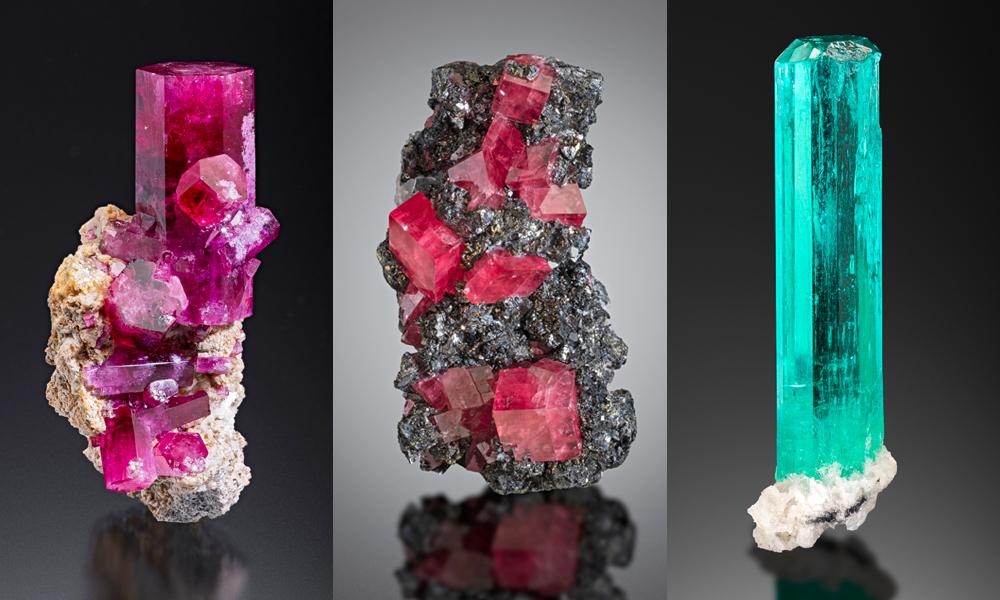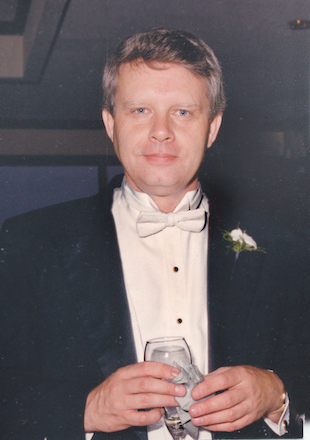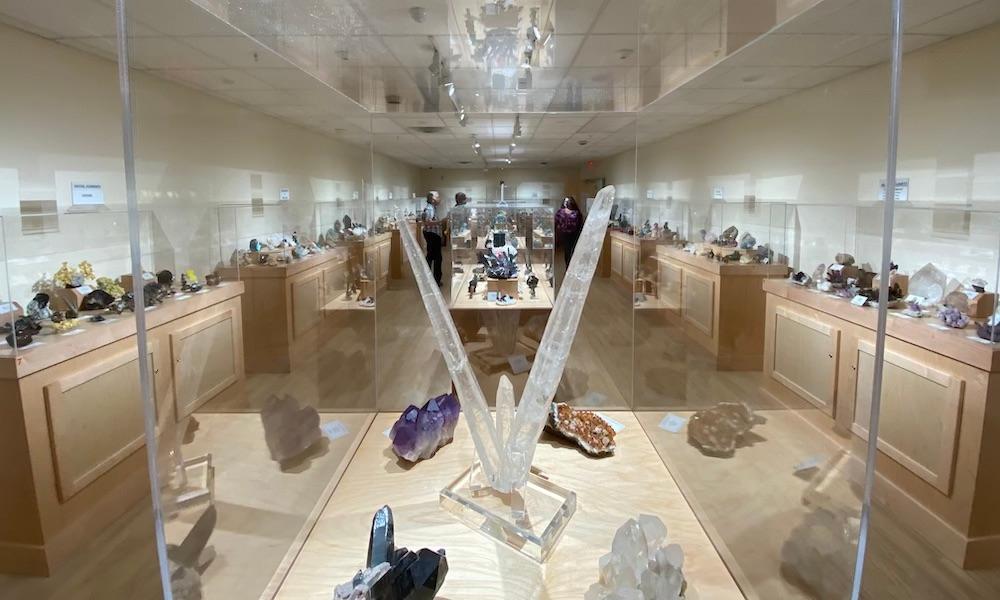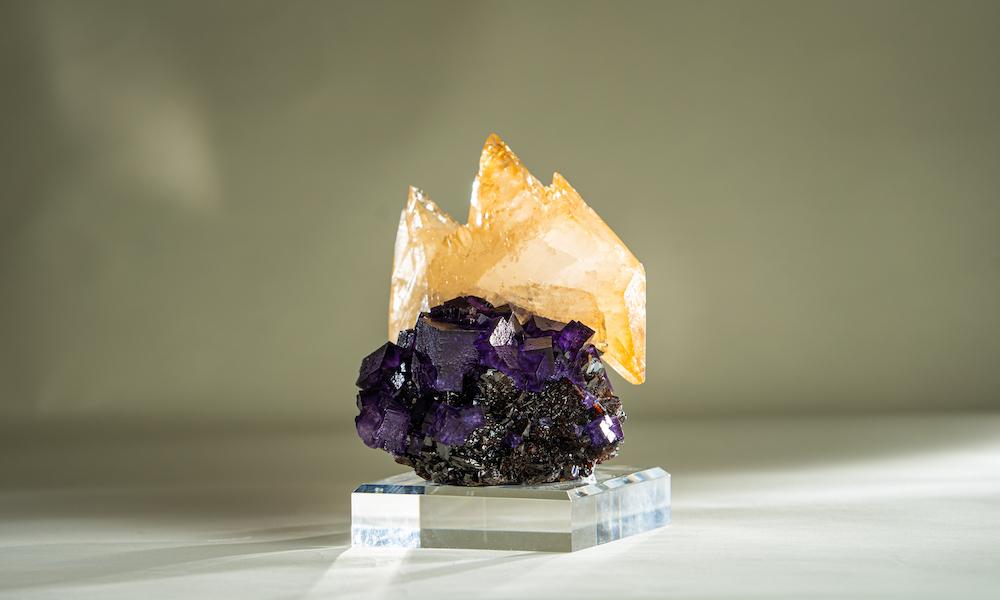Mega mineral gift
Via Collection revealed for the first time at JMU Mineral Museum
JMU NewsSUMMARY: An elite mineral collection that has been mostly hidden from view, even to professional mineralogists, will be open to dazzle both trained researchers and casual museum patrons.
James Madison University has received a mineral collection valued at more than $16.8 million from the late Peter L. Via of Roanoke, Virginia. The gift is the largest in JMU history and brings to $196,226,148 the total raised so far since the 2014 start of Unleashed: The Campaign for James Madison University. The campaign, JMU’s second ever, is focused on priorities that enrich the student and community experience and is on track to surpass its goal of $200 million by mid-2022.
“We are so pleased to be able to make this remarkable collection available to the public,” says President Jonathan R. Alger, who announced the estate gift at the Nov. 6 JMU Board of Visitors meeting. “This gift from Peter Via enhances the stature of science education at JMU just as last month’s Hartman Hall naming benefits our business programs. Truly, we are honored to receive this level of support from our donors during the Unleashed campaign.”
 |
|
| Photo by Jeff Scovil | Barite. A simple barium sulfate by composition with an orthorhombic crystal structure, barite is a relatively common mineral. These crystals from the Pohla Mine in Saxony, Germany, are exceptionally bright and colorful. |
“Mineral enthusiasts who come in, they’re going to look at the big gem crystals, the aquamarines, the emeralds, the tanzanites, the beautiful things,” says Lance Kearns, JMU emeritus professor of geology and curator of the JMU Mineral Museum. “A professional mineralogist might come in looking for the rare and unusual things. We have a specimen of hydroxylherderite, one of the largest crystals in the world. We also have a ferro-axinite crystal, one of the biggest in the world. So it depends on your point of view as to what is going to be special.”
The collection, adds Geology and Environmental Science Department Head Steve Leslie, “is most valuable because it’s accessible to a lot of people to experience. ... The real value is to society and the more we’re able to share it, I think the more we get out of the collection itself.”
The Via gift affirms JMU’s status in higher education, given that it is among only 25% of U.S. colleges and universities in the nation that have geology departments. And in this rarified world, JMU has attracted and developed top scholars — in part because of the geography of the Shenandoah Valley.
“This part of the world is rich with all kinds of really interesting geologic features,” says Cynthia Bauerle, who was dean of the College of Science and Mathematics when the bequest was realized. “So it’s no wonder that we have attracted the caliber of geoscientists that we have in JMU’s geology department. … We have geologists in our Geology and Environmental Science Department who publish in the best journals in the world, who have national and international reputations, who are at the forefront of their fields doing research. We have geologists who are involved in global research collaborations at polar expeditions. Our students benefit from that as a daily experience.”
The acquisition promises to solve a longtime mystery for mineral collectors who have only heard about Via’s collection and brings international attention to the JMU Mineral Museum, which for almost five decades has been a popular mid-Atlantic draw for mineral enthusiasts, tourists, and K-12 educators and schoolchildren.
A destination collection
“With the acquisition of the Peter Via mineral collection, James Madison University has suddenly become an important destination for serious mineral collectors, very few of whom have ever been granted an opportunity to see it,” Wendell Wilson of the Mineralogical Record reported in its September/October 2020 issue. The publication is considered the journal of record among mineral professionals and enthusiasts and worked in conjunction with world-renowned mineral photographer Jeff Scovil to be the first to visit JMU to photograph and report on the collection last year.
 |
|||
| Photos by Jeff Scovil | (Left to right): Red beryl. Less than 3 inches high, this crystal is one of the largest specimens known. Red beryl is extremely rare and specimens come almost exclusively from the Wah Wah Mountains of Utah. | Rhodochrosite on tetrahedrite. The color of this manganese carbonate is always some shade of pink. The two most common major crystal forms are the rhombohedron and the scalenohedron. This specimen comes from the Sweet Home Mine in Colorado. They are also most commonly found in the Kalahari Manganese fields of South Africa. | Emerald. A variety of the mineral beryl, crystals are hexagonal and prismatic in their geometry. Chemically they are beryllium aluminum silicates. The beautiful green color is a result of minor trace elements of chromium and vanadium. This specimen comes from Colombia, the world's most renowned location for gem quality emeralds. Usually cut into faceted stones, the crystals are hard to come by. |
“We have now become a destination collection,” Kearns says. “I already got a call from one of the New York State museum curators who wants to come and see the collection. We now have a situation where people are going to ... come here just to see the collection. They’ll come to JMU for that.”
Recognition is also coming in the form of invitations for the museum to display nationally and internationally, including from the Rochester Mineral Symposium in New York and the Munich Show (Mineralientage), the largest mineral trade show of its kind in Europe.
Driving this attention in part is the appeal of finally being able to lay eyes on a collection people had previously only heard about.
|
"Each specimen is a work of art by Mother Nature." — Lance Kearns, Curator and Founder, JMU Mineral Museum |
“What we’re looking at here with the Via Collection are some of the finest examples of these species in the world,” Kearns says. “Peter was known internationally. He was kind of reclusive. He ... never went out to shows. Basically, he would have people bring him material and he ... wanted the finest in the world. He would basically pay anything to get the No. 1 example of the species.”
According to the Mineralogical Record, “The Peter Via collection consists of 314 specimens chosen for their high quality and aesthetic appeal. ... The collection is particularly rich in suites of pegmatite minerals (tourmaline, topaz, beryl), azurite, calcite, barite, fluorite, quartz, gold and rhodochrosite. Rare species were not a focus of the collection, which instead relies on 76 relatively common species that are widely available in display quality.” Wilson reports they are “ … common, colorful, well-crystallized species.”

Peter L. Via
“The Via collection previously fell into the category of private (or even ‘secret’) high-end collections formed by wealthy individuals with no interest in sharing access to their treasures,” according to the journal. “Peter Via was one of those elusive, behind-the-scenes major mineral collectors.”
Via, who died Nov. 27, 2018, was born in California in 1941 and became a well-known Roanoke businessman and philanthropist. His parents’ family is known for its philanthropy, especially to Virginia Tech.
He was an avid hunter and fisherman and contributed to causes associated with the natural world. According to his obituary in the April issue of Rocks and Minerals, Via was known primarily in the world of American Saddlebred horse breeding. His Fox Grape Farm produced Callaways Copyright, a trotter who was the only six-time winner in the 100-plus-year history of the Harness World Grand Champion. Via and his wife, Lynn, were major financial donors to the American Saddlebred Museum.
Stepdaughter Claire Sullivan (’90) and husband, Tom (’90), are both JMU alumni and serve on the JMU Parents Council. Their son, Patrick (’21), is a College of Business senior due to graduate in May 2021.
In the mid-1990s, Via began a serious interest in collecting minerals, but the source of his fascination started much earlier and is not widely known. “He told me that when he was 5 or 6 and living in California he was kicking a rock and noticed it was full of little crystals and from then on, he said, he was transfixed,” says Kathy Sarver (’03M), the JMU development officer who worked with Via to arrange the estate gift.
A rare relationship
Lance and Cindy Kearns were among the rare few Via invited into his home to see and talk about his collection. No doubt word had reached Roanoke of their reputations as scholars, researchers and teachers. But spurring that attention was also their intense involvement with mineral enthusiasts and clubs around Virginia and the central Appalachian and mid-Atlantic regions.
“Lance always had a high appreciation for mineral collectors outside of the academic community,” his department head explains. “His passion for that was such that he would meet with clubs, and he was the true professional who was accessible to mineral clubs and societies. He would bring them to campus and run events for them, identify minerals with them. He treated them with a tremendous amount of respect and enjoyment and did a huge amount of outreach and education.”
Via relied on the Kearnses’ expertise and, now and again, he would donate a specimen to the museum. Yet their long relationship got off to a rocky start.
“He called me one day before we ever met and asked me whether the museum had security,” Kearns says. “I said, ‘huh?’ and he hung up. I didn’t know who he was.”
That phone call occurred in the early days of the JMU Mineral Museum, when it was located in glass cases and drawers in Miller Hall. Later, in the 2000s, Bauerle’s predecessor as dean, David Brakke, recognized the museum’s value and made the investment to move it into secure display cases in Memorial Hall, the former Harrisonburg High School. There it served geology majors and other JMU students who took geology courses. It also became a regular stop for science field trips from area schools and a focal point for regional mineralogical societies, whose financial support helped purchase the cases and underwrite JMU student geology trips into the field.
Luckily, by that time, Via had called back, and the two never spoke of the earlier exchange. The relationship between Via and the Kearnses ultimately led to Via’s bequest of his collection to JMU.
JMU Mineral Museum
Several years ago, JMU invested in a brand new headquarters with specialized lighting, display cases, security and storage in the Festival Conference and Student Center, making way for the museum to become one of the final science assets to make the move to JMU’s East Campus hub for the science disciplines. The Mathematics and Statistics Department and Wells Planetarium remain in Miller Hall.
 |
The museum has been on hiatus for the move and a complete rethinking of the presentation to allow for integrating the Via collection.
“The original collection in Memorial Hall was arranged in a systematic display, meaning that minerals were displayed and classified based on their chemical composition and atomic structures,” explains Cindy Kearns, who serves as the museum’s interim collections manager. “With the addition of the Via collection, we ... still have a systematic classification, but with the large amounts of single species, we want to be able to highlight those individual species as well. So you’ll see that there is still some systematic appearance to it. But then there are specialty cases — the beryl case or the tourmaline case or the fluorite case — rather than just the individual classes of minerals.”
The Via collection’s 314 specimens increase the museum’s mineralogical holdings and constitute its third major collection. The museum also features the JMU Collection, which the Kearnses have developed over four decades of research and acquisition, including their own contributions of specimens. The other major collection is the Virginia Mineral Collection, funded by Richard S. Mitchell in 1989 and endowed by his father, Clarence Mitchell, in 1993. “It is probably one of — if not the — finest collection of Virginia minerals,” Kearns says.
The museum currently displays 378 exhibits in 18 cases, including the Fluorescent Collection in a room with ultraviolet light. Overall, the museum holds more than 1,770 catalogued specimens. Most are in storage for possible later rotation into exhibition, including 5,000 micromounts from the collections of Phil Cosminsky and Fred Keidel. Specimens come from 39 countries and 24 U.S. states with emphasis on Elmwood, Tennessee, and Franklin and Sterling Hill, New Jersey.
Something for everyone
The infusion of the Via Collection will intensify the mineral museum’s ongoing role in JMU’s STEM outreach and “serve as a vehicle or a portal for a young person,” Bauerle says. “All of a sudden, they start thinking, ‘Gee, how does something so beautiful form naturally? What does it mean that it takes thousands of years or millions of years for a structure like this to form? Why does this structure look like this? And this one looks so very different? What are the conditions that lead to that? How would I learn more about that?’ Those are the questions that a scientist might ask. And I think that’s always what we’re trying to do when we showcase the collections that we have. We showcase the kinds of things that we’re doing here at JMU. It’s always about how we can make the science ... accessible and ... excite their imagination.
 |
| Purple and gold provide a JMU dazzle to many of the specimens in the Via Collection. The JMU Mineral Museum staff has chosen this piece, from the Elmwood-Gordonsville zinc mines in Smith County, Tennessee, to serve as its publicity or “icon” specimen. The yellow points (gold) are calcite crystals that sit on purple fluorite crystals. These in turn sit on a dark reddish brown mineral called sphalerite, which is the main ore mineral of zinc. |
|
"They’re going to look at aquamarines the size of your hand, emeralds, tanzanite, crystal ... and be wowed by them.” — Lance Kearns, Curator and Founder, JMU Mineral Museum |
“We’re a public institution, and so it is our mission to provide opportunities for learning to our community, to the Commonwealth [of Virginia],” Bauerle emphasizes. “I think this is a beautiful example of how we do that, stewarding a relationship that led to the opportunity that we have to showcase this really spectacular collection. It resonates very directly with our mission. I think that’s something to celebrate.”
Visitors will come to see the collection for different reasons, Kearns explains. “The professional mineralogist has seen a lot of fluorite, but … he or she is going to be there to look for the rare, the unusual. They’re concerned about the atomic structure, the chemical processes and the geologic environment that gave rise to the specimens. The person who is just interested in minerals is going to come in, they’re going to look at aquamarines the size of your hand, emeralds, tanzanite, crystal. ... They’re going to look at the things that they know and be wowed by them.”
Public premiere pending
The Via Collection’s public premiere had been scheduled for spring 2020 as part of the grand reopening of the museum in its new secure location in the Festival Conference and Student Center, but has been postponed until further notice because of COVID-19 restrictions. When the museum is able to open, the mystery surrounding the Via collection will finally be resolved as collectors and others from around the world are able visit and see Via’s specimens for themselves. Until then, visits for the curious are possible by appointment only, dependent on the discretion of museum staff.
###

